If your mood calls for something delicately floral and creamy, this wonderful recipe of “Halawet el jibn” would be right up your alley. Market stalls? with echoes of languages foreign to my ears. A delicious native Syrian treat H a l a w e t e l j i b n (literally, “The sweetness of Cheese”) is a type of rolled pastry, or ‘Swiss roll’ filled with sweet cream and soaked in lightly spiced syrup. This sweet and fragrant dessert now has the whole of Middle Eastern people yearning for more, and of course is becoming just as popular worldwide for that irresistible taste.
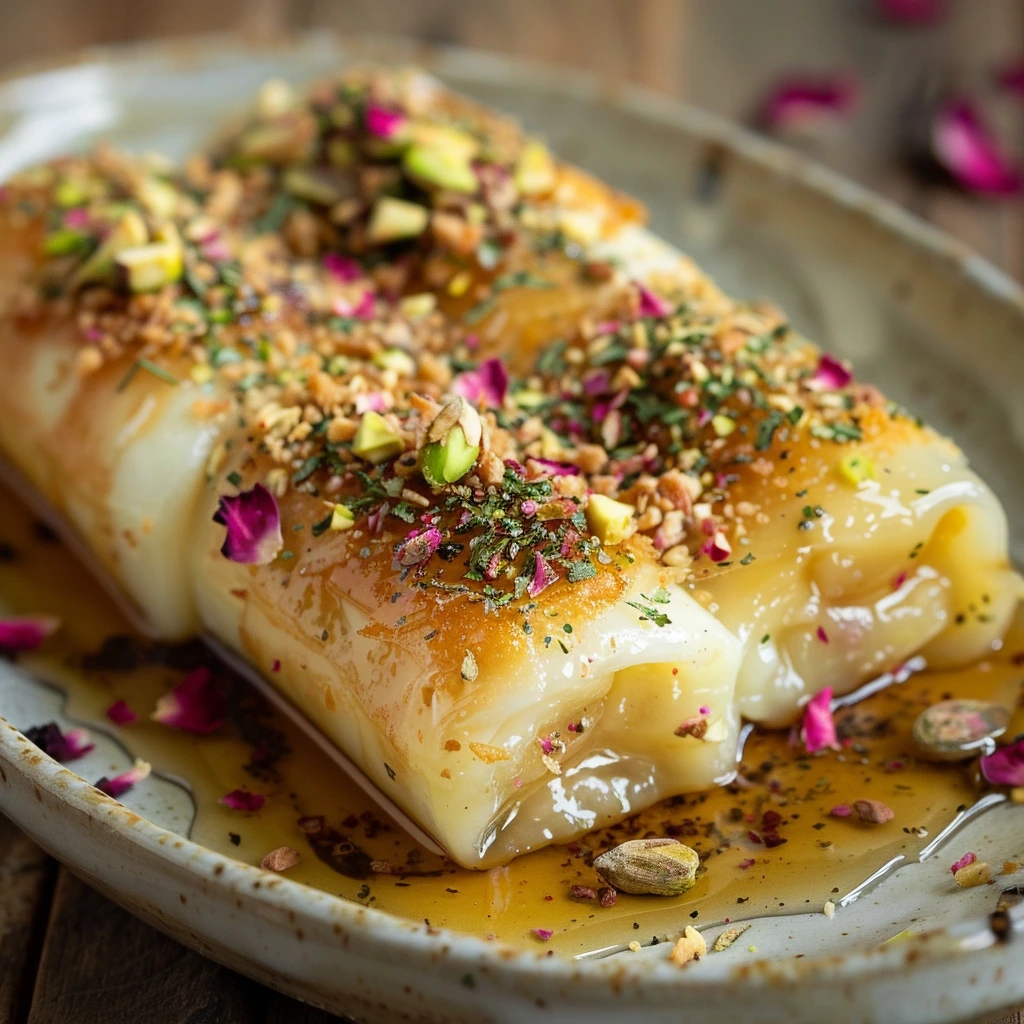
If you are planning a special occasion, or just want to please the folks at home, this detailed guide takes you through all of the steps in cooking at holiday meal. We’ll investigate the dish’s origins; we will give you some useful things to know, and answer your queries.
Table of Contents
1. What is Halawet El Jibn?
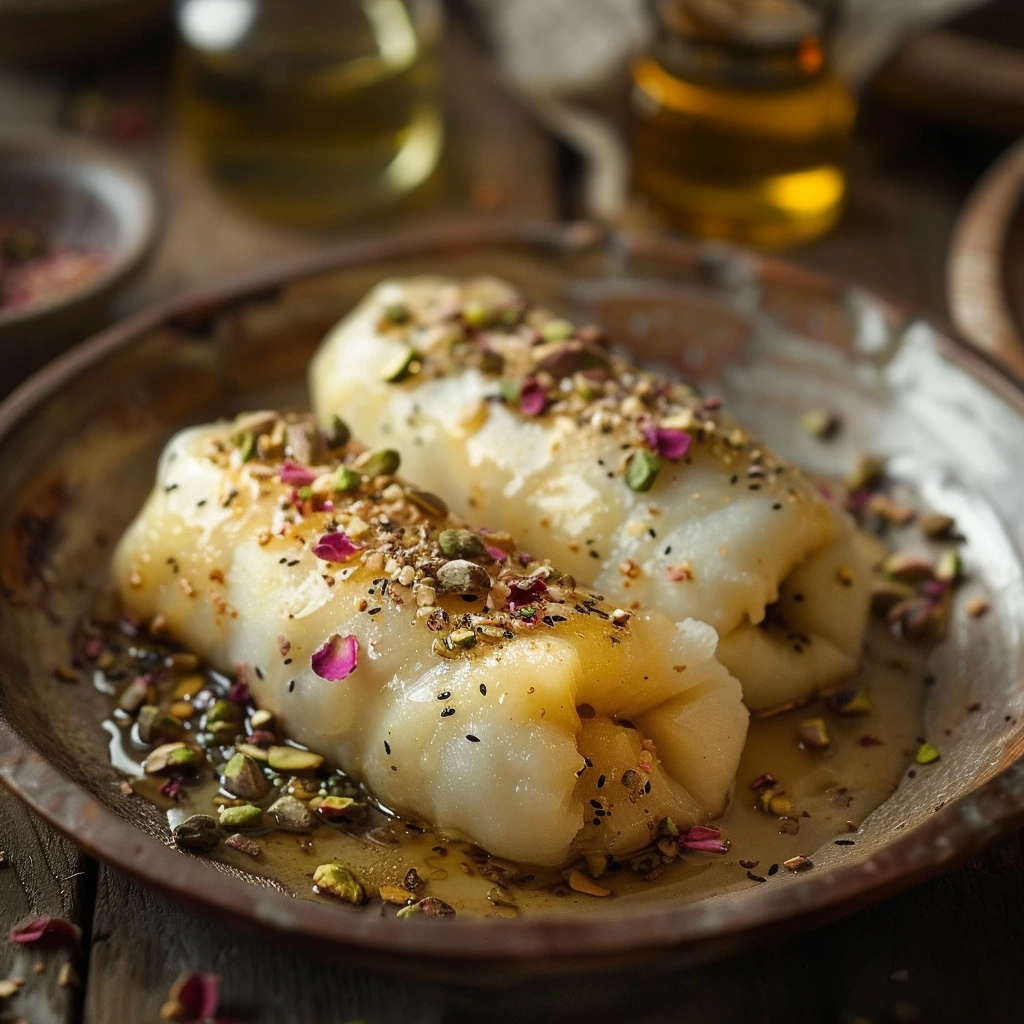
The Arabic name for Halawet el jibn means “sweet of the cheese.” This delectable sweetmeat is made from a cooked dough which is a combination of fine semolina and cheese. It is rolled into ashta a soft cheese mixture rich with traditional Arab flavor, full-bodied in texture yet only slightly sweet. End touches come from fragrant sugar syrup with the ever-popular topping of pistachios for garnish.
What makes this special sweet so enjoyable is that the texture is soft and flexible, perfect yet not overly sweet. It is a wonderful example of Levantine cooking: here the flowery aqua, dairy and nuts all meet in exact measure for harmony.

2. The Cultural Significance of This Syrian Sweet
The Halawet el jibn recipe Even street vendors in Syria and Lebanon sell fresh hallowe’een el jibn, which is made right in front of you with timing for perfection.
With that in mind, it’s an excellent dessert to have along with Arabic coffee or mint tea; after a full meal this cool and refreshing treat will bring back some life.
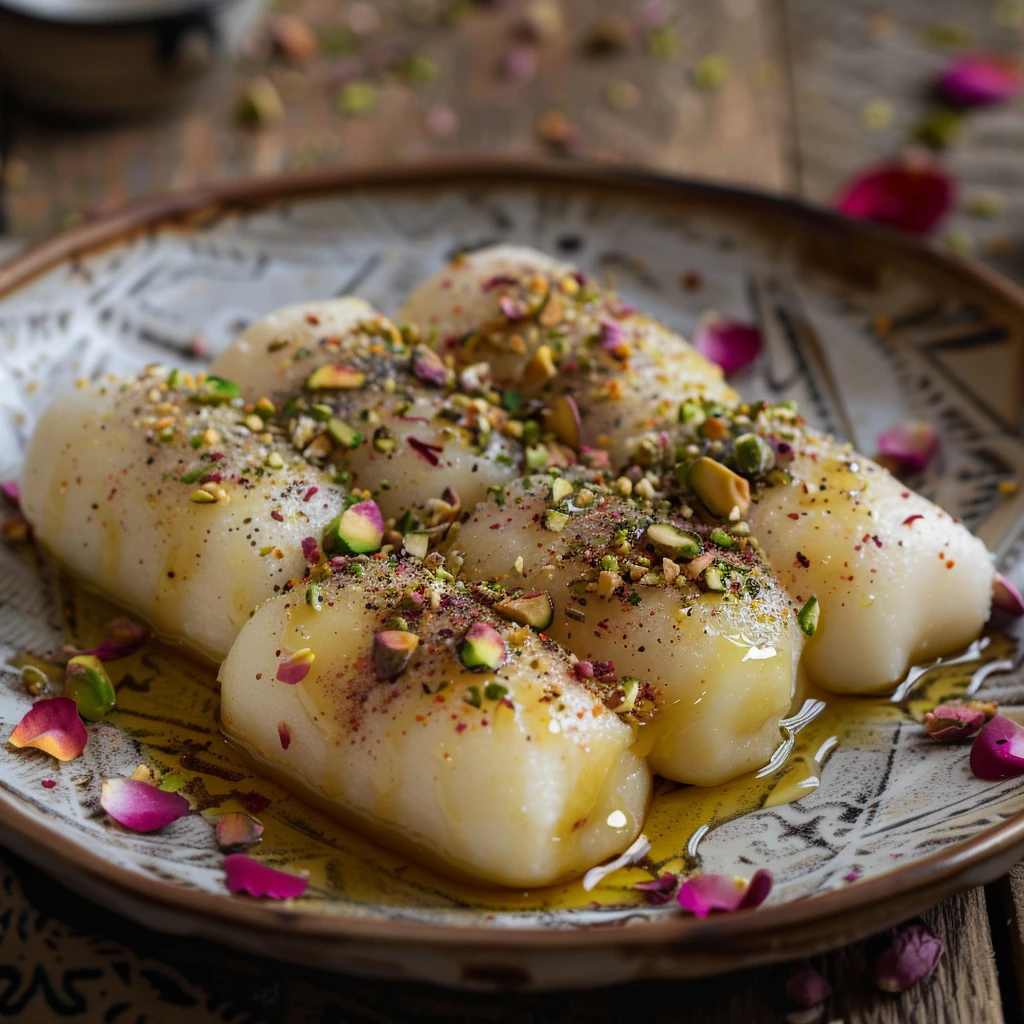
3. Key Ingredients and Substitutions
Dough Ingredients:
- 1 cup fine semolina: Gives the dough its signature smoothness.
- 1/2 cup sugar: Provides sweetness.
- 1 cup water: For moisture.
- 1 tablespoon rose water + one tablespoon orange blossom water: For aroma and traditional flavour.
- 1 cup shredded cheese: Traditionally made with Akkawi or Nabulsi, but mozzarella can be used for a milder version.

Filling Ingredients:
- 1 cup homemade ashta: Or substitute with thickened heavy cream.
- Optional: A dash of powdered sugar for extra sweetness.
Syrup Ingredients:
- 1 cup sugar
- 1/2 cup water
- 1 teaspoon lemon juice
- 1 tablespoon rose water
Garnish:
- Crushed pistachios
- Dried rose petals (optional)
4. Required Tools and Kitchen Setup
To successfully make a hallowed el job, you’ll need:
- Non-stick saucepan
- Rolling pin
- Spatula or wooden spoon
- Parchment paper or silicone mat
- Sharp knife or pizza cutter
- Tray or flat surface
- Piping bag (optional)
Tip: Keep your tools ready ahead of time, as timing is crucial in this recipe.
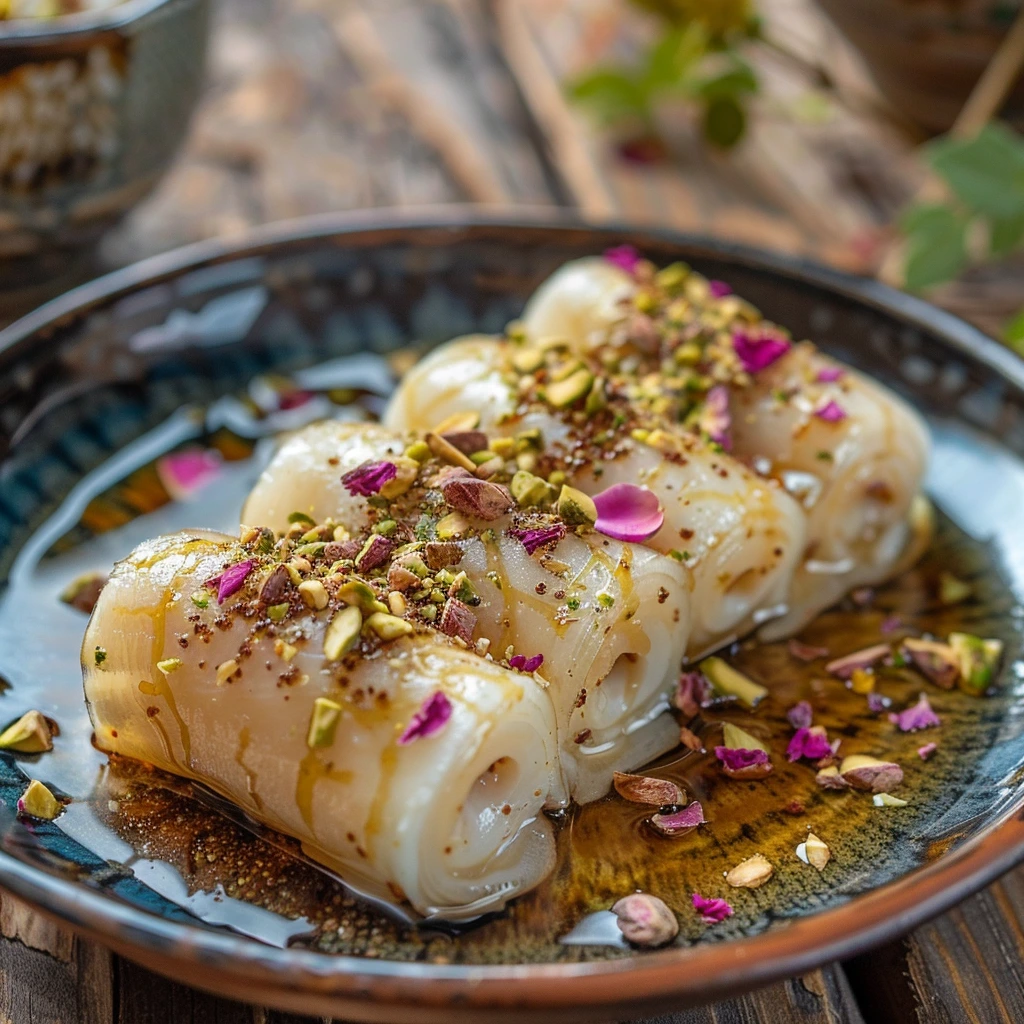
5. Authentic Halawet El Jibn Recipe: Step-by-Step
Making the Syrup:
- In a saucepan, combine sugar and water.
- Heat until sugar dissolves, then boil for 7–10 minutes.
- Add lemon juice and floral water.
- Cool completely before using.
Preparing the Dough:
- In a non-stick saucepan, combine semolina, sugar, and water.
- Stir continuously over medium heat until the mixture thickens.
- Add the shredded cheese and stir until it is melted and smooth.
- Add rose water and orange blossom water.
- Transfer the dough to a parchment-lined surface.
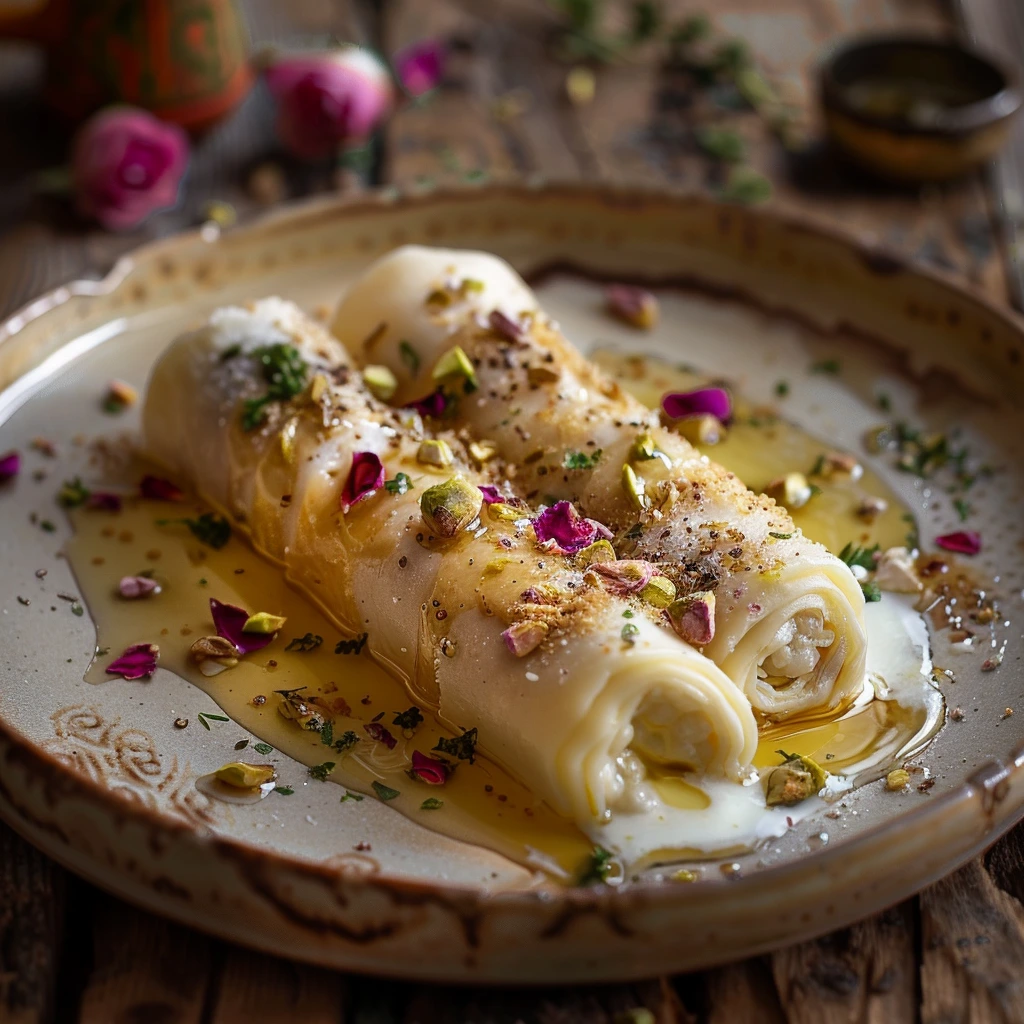
Making Homemade Ashta (Arab Cream Cheese):
- Heat 2 cups whole milk with 1 tbsp sugar.
- In a separate bowl, mix one tablespoon of cornstarch with 1/4 cup of water.
- Stir the slurry into the milk and continue to heat.
- Once thickened, add 1/4 cup heavy cream.
- Cool and refrigerate until needed.
Assembling the Rolls:
- While the dough is warm, roll it into a thin rectangle.
- Pipe or spoon a line of ash along one side.
- Carefully roll the dough over the cream.
- Cut into 2-inch rolls.
- Drizzle with cooled syrup and garnish.
6. Tips for Success: Getting the Texture Just Right
- Use unsalted cheese to avoid an overpowering savoury taste.
- Don’t overheat the dough, or it may become rubbery.
- Work quickly: The dough is easier to handle while warm.
- Cool syrup completely before drizzling to prevent sogginess.
7. Halawet El Jibn Across the Arab World
Lebanese also sometimes add a little whipped cream to the milk mixture In Jordan, variations often feature cardamom or cinnamon. Egyptians may use ricotta or other local cheeses In terms of local flavor, each area gives its own unique contribution, but the fundamentals are soft dough,rich cream and fragrant syrup.
8. Nutritional Information and Dietary Adaptations
NutrientPer Piece (approx.)
Calories 150–180 kcal
Fat 6–8g
Carbs 20–25g
Protein 3–5g
Dietary Tips:
- Vegetarian: This recipe is naturally vegetarian.
- Gluten-free: Use gluten-free semolina or cornstarch-based dough.
- Low-sugar: Reduce sugar in syrup and dough.
9. Serving Suggestions and Pairings
- Serve cold for the best texture.
- It pairs beautifully with mint tea, Arabic coffee, or even chai.
- Add seasonal fruits, such as figs or berries, for a colourful presentation.
- Serve in elegant paper cups for gatherings or special occasions.
10. Storage and Make-Ahead Tips
- Refrigerate in an airtight container for up to 3 days.
- Don’t freeze: Freezing changes the texture.
- Make ahead: You can prepare the dough and ashta separately and assemble them just before serving.
11. Common Mistakes to Avoid
- Using salty cheese.
- Letting the dough cool too much before rolling.
- Skipping the rose/orange blossom water.
- Overcooking the syrup.
12. Final Thoughts and Conclusion
This hallowed el jib recipe is more than just a dessert—it’s a piece of cultural heritage. With its soft texture, rich filling, and fragrant finish, it’s no wonder this Syrian treat has found its way into the hearts of people across the world. Whether you’re a seasoned cook or a beginner, this guide gives you all the tools you need to create an authentic, unforgettable halawat el jibn at home.
13. FAQ
1. Can I use mozzarella for the Holy El Jib recipe?
Yes! Low-moisture, unsalted mozzarella is a common substitute for traditional Arab cream cheese in this hallowed jib recipe.
2. Is halawet el jibn difficult to make?
Not at all. With the right tools and timing, it’s straightforward—even for beginners.
3. What’s the difference between Halawet el jibn and Kanafeh?
Kanafeh uses shredded phyllo dough, while Hallowed el jib uses cooked semolina-cheese dough. Both are traditional Syrian sweets but differ in texture and preparation.
4. Can I make halawet el jibn vegan?
Of course, the texture will be different but not essentially better. There must be other ways to sustain these very popular recipes.
Whether you make this recipe or not, you can look forward to savoring a cream dessert which is worth its weight in gold.
And if you do make it, look forward to the smell of smells wafting through your kitchen–the kind that would not anyway seem out place on any bustling street in Damascus.
Check out my website for more tasty recipes like this one
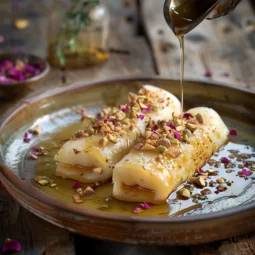
Halawet El Jibn (Syrian Sweet Cheese Rolls)
Equipment
- Non-stick saucepan
- Wooden spoon or silicone spatula
- Rolling Pin
- Parchment paper or silicone mat
- Sharp knife or pizza cutter
- Mixing bowls
- Saucepan (for syrup)
- Piping bag (optional)
Ingredients
- For the Dough:
- 1 cup fine semolina
- 1/2 cup sugar
- 1 cup water
- 1 tablespoon rose water
- 1 tablespoon orange blossom water
- 1 cup unsalted shredded cheese Akkawi, Nabulsi, or low-moisture mozzarella
- For the Ashta Filling:
- 2 cups whole milk
- 1 tablespoon sugar
- 1 tablespoon cornstarch
- 1/4 cup water
- 1/4 cup heavy cream
- For the Syrup:
- 1 cup sugar
- 1/2 cup water
- 1 teaspoon lemon juice
- 1 tablespoon rose water
- For Garnish:
- Crushed pistachios
- Dried rose petals optional
Instructions
- Make the Syrup (First, to allow cooling):
- In a saucepan, combine sugar and water.
- Bring to a boil and simmer for 7–10 minutes.
- Add lemon juice and floral water.
- Let it cool completely.
- Prepare the Ashta Filling:
- In a saucepan, heat milk and sugar.
- In a small bowl, mix cornstarch with water.
- Add the slurry to the milk, stir until thickened.
- Stir in heavy cream.
- Let cool and refrigerate until ready to use.
- Make the Dough:
- In a non-stick saucepan, combine semolina, sugar, and water.
- Stir constantly over medium heat until thick.
- Add shredded cheese and stir until fully melted.
- Mix in rose and orange blossom water.
- Spread the dough on parchment paper into a thin rectangle.
- Assemble the Halawet El Jibn Rolls:
- While dough is still warm, spoon or pipe ashta in a straight line along one side.
- Gently roll the dough over the filling, creating a tight log.
- Cut into 2-inch rolls using a knife or pizza cutter.
- Arrange on a serving plate.
- Finish & Garnish:
- Drizzle with the cooled syrup.
- Sprinkle with crushed pistachios and rose petals if using.
- Serve cold for best texture.
